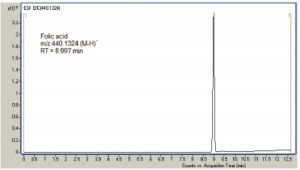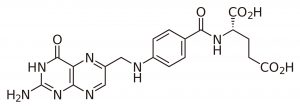Minimized Sample Prep & Increased Sensitivity for Vitamin B9
A sensitive and reliable Method was developed for the determination of Folic Acid (FA) and can be used in many applications including complex sample matrices without the Solid-Phase Extraction clean up. Since the method uses LC-MS (negative-ion) it provides sensitivity as well as great selectivity. The use of chelating agents or high concentration of salts in the Mobile Phase or Ion Pair Reagents (non MS compatible) are not required as in older methods for FA analysis.
The LOQ is dramatically better than existing Methods with UV detection. When this methodology is used very fast equilibration between Gradients is observed as well. Twenty consecutive injections resulted in %RSD = 0.26.


Peak:
Folic Acid
Method Conditions
Column: Cogent Diamond Hydride™, 4μm, 100Å
Catalog No.: 70000-15P-2
Dimensions: 2.1 x 150mm
Mobile Phase:
—A: DI Water / 10 mM Ammonium Acetate
—B: 90% Acetonitrile / 10% DI Water / 10 mM Ammonium Acetate. pH = 7 adjusted using Ammonia
Gradient:
| Time (minutes) | %B |
| 0 | 100 |
| 5 | 90 |
| 9 | 50 |
| 10 | 100 |
Post Time: 5 minutes
Flow rate: 0.4mL / minute
Detection: ESI – neg – Agilent 6210 MSD TOF Mass Spectrometer
Sample Preparation: Sample stock solution was made in Solvent A at a concentration of 2.0mg / L. Sample for analysis was made by diluting the stock with Solvent A, to which 0.1% Ammonia was added. Sample final concentration was 0.2mg / L. Please note that Folic Acid sample was prepared in Solvent A only as opposite to samples of other acids which are prepared in 50% mixture of Solvents A and B. When the sample of Folic Acid was prepared in 50:50 A / B the MS signal was lower.
Notes: Deficiency of Folic Acid (Vitamin B9) is associated with several chronic diseases (for example macrocytic anaemia, psychiatric disorders, neutral tube defects in newborns, cancer, Alzheimer’s disease and cardiovascular disease in adults [1]; thus accurate assessment of folate status has become important in the clinical setting, in epidemiological studies in clinical and research laboratories. FA cannot be synthesized by mammalian cells and therefore must be supplied with diet. It is very important to establish highly sensitive methods for the quantitative determination of trace amounts of this vitamin.
[1]. B.C. Nelson, K.E. Sharpless, L.C. Sander; J. Chromatogr. A, 1135 (2006) 203-211
Attachment
No 105 Folic Acid Analyzed by LCMS pdf 0.1 Mb Download File


